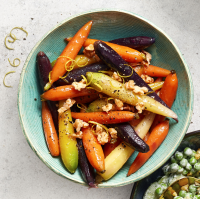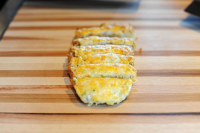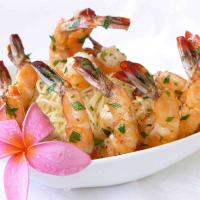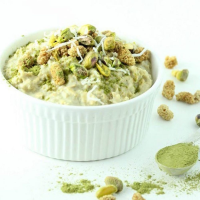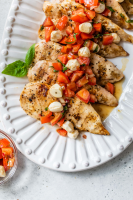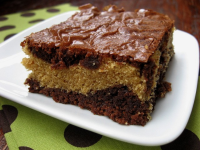HOSHIGAKI (DRIED PERSIMMONS) RECIPE - NYT COOKING

Japanese hoshigaki are a special, seasonal treat made with firm, astringent Hachiya persimmons that are dried for a few weeks until they become extremely tender and sweet. The prep is a little intensive — each fruit must be peeled, dunked in boiling water and suspended in such a way that it doesn’t touch anything, to discourage mold from forming. If the stems haven’t been cut so they’re easy to tie with string, they will require binder clips or another makeshift hanging solutions. But after the persimmons are set up, all they need is plenty of time, sunlight and air to transform into succulent hoshigaki. Slice the dried fruit and nibble it as is for dessert, pair it with good cheese, or toss it into a simple green salad.
Provided by Tejal Rao
Total Time 1 hours
Yield 24 persimmons
Number Of Ingredients 2
Steps:
- Wash the fruit well. Remove the leaves, then use a knife or vegetable peeler to remove the peel from the crown of the fruit around the stem. Continue to peel the entire fruit, leaving the stems intact and cutting out any brown spots. Set up a rack or bar, such as a clean laundry rack, near a window with a large piece of parchment underneath. You should be able to suspend the fruit so they don’t touch one another or any other surfaces.
- Tie and sterilize the fruit: Cut a 20-inch piece of thin string for every 2 persimmons and tie the string to the stems of the persimmons using no-slip knots on both ends of each piece. Trim excess string if needed. If the stems aren’t long enough to tie, fix binder clips to the stems and tie those. If the stems aren’t long enough for that, run short bamboo skewers through the tops of the persimmons and tie the skewers. Bring a pot of water to a boil and, holding each piece of string at the center, dunk the fruit for a few seconds, then lift out.
- Hang each string over the prepared rack, so the fruit is dangling on either side of the bars, but not touching anything. Ideally, keep the rack in a sunny, dry, well-ventilated spot, either indoors or outdoors.
- After a week of drying, you can start to lightly knead the fruit every day, rolling each one gently in clean hands to help it dry evenly. Watch for any mold, which you can remove with a cotton swab dipped in alcohol, and for firm spots, which you can focus on when you knead the fruit.
- Over the course of about 3 weeks, the persimmons will shrivel and shrink, and its sugars will come up to the surface and crystallize, forming a white layer. Once the sugar is visible, you can eat the fruit or continue to dry them, and you can stop kneading them. When the fruit is firm and dark and more powdery sugar covers the surface, it’s ready to remove from the drying rack and store in an airtight container at room temperature for up to 1 month or in the freezer for up to 6 months. It tastes best immediately after drying, when you can slice and eat it as is.
HOSHIGAKI (DRIED PERSIMMONS) RECIPE - NYT COOKING

Japanese hoshigaki are a special, seasonal treat made with firm, astringent Hachiya persimmons that are dried for a few weeks until they become extremely tender and sweet. The prep is a little intensive — each fruit must be peeled, dunked in boiling water and suspended in such a way that it doesn’t touch anything, to discourage mold from forming. If the stems haven’t been cut so they’re easy to tie with string, they will require binder clips or another makeshift hanging solutions. But after the persimmons are set up, all they need is plenty of time, sunlight and air to transform into succulent hoshigaki. Slice the dried fruit and nibble it as is for dessert, pair it with good cheese, or toss it into a simple green salad.
Provided by Tejal Rao
Total Time 1 hours
Yield 24 persimmons
Number Of Ingredients 2
Steps:
- Wash the fruit well. Remove the leaves, then use a knife or vegetable peeler to remove the peel from the crown of the fruit around the stem. Continue to peel the entire fruit, leaving the stems intact and cutting out any brown spots. Set up a rack or bar, such as a clean laundry rack, near a window with a large piece of parchment underneath. You should be able to suspend the fruit so they don’t touch one another or any other surfaces.
- Tie and sterilize the fruit: Cut a 20-inch piece of thin string for every 2 persimmons and tie the string to the stems of the persimmons using no-slip knots on both ends of each piece. Trim excess string if needed. If the stems aren’t long enough to tie, fix binder clips to the stems and tie those. If the stems aren’t long enough for that, run short bamboo skewers through the tops of the persimmons and tie the skewers. Bring a pot of water to a boil and, holding each piece of string at the center, dunk the fruit for a few seconds, then lift out.
- Hang each string over the prepared rack, so the fruit is dangling on either side of the bars, but not touching anything. Ideally, keep the rack in a sunny, dry, well-ventilated spot, either indoors or outdoors.
- After a week of drying, you can start to lightly knead the fruit every day, rolling each one gently in clean hands to help it dry evenly. Watch for any mold, which you can remove with a cotton swab dipped in alcohol, and for firm spots, which you can focus on when you knead the fruit.
- Over the course of about 3 weeks, the persimmons will shrivel and shrink, and its sugars will come up to the surface and crystallize, forming a white layer. Once the sugar is visible, you can eat the fruit or continue to dry them, and you can stop kneading them. When the fruit is firm and dark and more powdery sugar covers the surface, it’s ready to remove from the drying rack and store in an airtight container at room temperature for up to 1 month or in the freezer for up to 6 months. It tastes best immediately after drying, when you can slice and eat it as is.
HOW TO MAKE HOSHIGAKI (JAPANESE DRIED PERSIMMONS)
Mar 25, 2020 · For hoshigaki, however, you will need to use hachiya persimmons. These are longer and pointed. When unripe, they are firm, but as they ripen, the flesh becomes gelatinous. Unripe hachiyas are not edible. The flesh is intensely tannic and bitter. To make hoshigaki, though, you want them still unripe and quite firm.
From thespruceeats.com
From thespruceeats.com
See details
HOW TO MAKE 'HOSHIGAKI' AT HOME | EDIBLE BROOKLYN
Dec 20, 2019 · How to Make Hoshigaki. You need firm persimmons, stainless-steel screws, and twine. Sterilize the screws by boiling them, or cover them in high-proof liquor. Wash your hands. Peel the persimmons. Twist the screws into the top of each fruit, drilling through the papery calyx and as deep as you can go. Tie string to the screw heads.
From ediblebrooklyn.com
From ediblebrooklyn.com
See details
HOW TO MAKE HOSHIGAKI (JAPANESE DRIED PERSIMMONS) | KYOTO ...
Dec 15, 2012 · Best of all, making hoshigaki is really easy, and it is fun. Gather some friends or family and make a big bunch of them and give some out to people for year end presents! Any kind of persimmon can be used but the two most popular, I think, are the hachiya and shibu varieties.
From kyotofoodie.com
From kyotofoodie.com
See details
WHEN LIFE HANDS YOU PERSIMMONS, MAKE HOSHIGAKI
Jan 04, 2022 · Hoshigaki is made from firm hachiyas with just the right tad of softness, and preferably a longish stem. Anybody can make it – just keep in mind that there is no one exact right way and, like wine-making, there are lots of different techniques, and outcomes vary with the maker.
From recipes.howstuffworks.com
From recipes.howstuffworks.com
See details
HOW TO MAKE HOSHIGAKI (DRIED PERSIMMONS) | ROOT SIMPLE
Nov 13, 2012 · Cut a 24 inch length of string and tie it into a loop. Take two similarly sized fruit and tie their stems together with the string: A 2 inch diameter bamboo pole is just about right to keep the persimmons separated. A sunny window is a good place to hang the persimmons.
From rootsimple.com
From rootsimple.com
See details
DRYING PERSIMMONS | HOSHIGAKI RECIPE | SHOCKINGLY DELICIOUS
Nov 16, 2014 · Using a small paring knife, remove the skin from each persimmon. If the persimmon has a branch attached, tie twine to the branch and hang it over the rack. Repeat with other persimmons. If the persimmon has no branch attached, insert a small metal screw into the top of the persimmon, and attach the twine to that screw.
From shockinglydelicious.com
From shockinglydelicious.com
See details
HOW TO MAKE HOSHIGAKI - THE KOSMIC KITCHEN
Dec 01, 2017 · How to Make Hoshigaki The first time I tasted a Japanese dried persimmon, I couldn't get over its incredible flavor, texture and scent. The whole experience of eating just once slice felt like a meditation.
From thekosmickitchen.com
From thekosmickitchen.com
See details
HOSHIGAKI : 5 STEPS - INSTRUCTABLES
HoshiGaki: To be eaten fresh, the Hachiya persimmon must be completely soft, otherwise it is unbearably astringent. For drying, however, the fruits are perfect when the shoulders just lose their green, but are still firm like apples, generally from the end of …
From instructables.com
From instructables.com
See details
WHEN LIFE HANDS YOU PERSIMMONS, MAKE HOSHIGAKI
Jan 04, 2022 · Hoshigaki is made from firm hachiyas with just the right tad of softness, and preferably a longish stem. Anybody can make it – just keep in mind that there is no one exact right way and, like wine-making, there are lots of different techniques, and outcomes vary with the maker.
From recipes.howstuffworks.com
From recipes.howstuffworks.com
See details
HOW TO MAKE HOSHIGAKI - THE KOSMIC KITCHEN
Dec 01, 2017 · The first time I tasted a Japanese dried persimmon, I couldn't get over its incredible flavor, texture and scent. The whole experience of eating just once slice felt like a meditation. Once I found out how they were made, I was immediately intimidated and thought making hoshigaki would be something
From thekosmickitchen.com
From thekosmickitchen.com
See details
HOSHIGAKI: DRIED PERSIMMONS AT HOME - LIFE & THYME
Nov 15, 2019 · With persimmons, I make hoshigaki, an ancient Japanese method of drying persimmons; the recipe is in my new book, Japanese Home Cooking: Simple Meals, Authentic Flavors. The Hachiya variety is not edible when they are firm. Their flesh is intensely tannic and bitter. You have to let the fruit ripen until it turns pulpy and jelly-like.
From lifeandthyme.com
From lifeandthyme.com
See details
SOME PEOPLE GOT INTO SOURDOUGH. I LEARNED HOW TO MAKE ...
Jan 07, 2021 · Hoshigaki (from the Japanese terms hoshi, meaning dried, and kaki, persimmon) are dried persimmons, made with a centuries-old technique that’s both incredibly simple and ridiculously labor ...
From eater.com
From eater.com
See details
ULTIMATE GUIDE TO HOSHIGAKI, JAPANESE DRIED PERSIMMON ...
Sep 24, 2018 · Autumn is the best season to make dried Japanese persimmon, usually in October or November (or when the temperature is below 50 degrees Fahrenheit). If it’s too warm or humid, the fruit will mold. Even when totally dried, hoshigaki does not store well, so proper storage is crucial to preserving the fruits of your labor.
From umami-insider.com
From umami-insider.com
See details
HOW TO MAKE DRIED PERSIMMONS - SUNSET MAGAZINE
Aug 31, 2018 · Hoshigaki to Go . Not everyone has a Hachiya persimmon tree in their backyard to make their own hand-massaged hoshigaki. You can, however, find the treats online through Penryn OrchardSpecialties.com ($45/lb).Of course, they’d work well in recipes that call for dried fruit—couscous, salads, desserts—but for an ingredient made with such handcrafted care, sometimes it’s best to enjoy the ...
From sunset.com
From sunset.com
See details
JAPANESE DRIED PERSIMMONS ARE WORTH EVERY MASSAGE | BON ...
Mar 07, 2018 · A packaged dried persimmon from Vietnam, where hoshigaki-making is alive and well. But if it’s hoshigaki or bust, you can order a case from Otow Orchard or Penryn Orchard, both of which are in ...
From bonappetit.com
From bonappetit.com
See details
66 SQUARE FEET (PLUS): HOW TO MAKE HOSHIGAKI
Nov 05, 2021 · How to Make Hoshigaki: You Need: Firm persimmons. And they can be any kind. The ones above are Fuyu. But even astringent Hachiyas must be firm or you can't peel them. They will turn sweet, I promise. A potato peeler and a very sharp, small knife. Stainless steel screws, one for each fruit.
From 66squarefeet.blogspot.com
From 66squarefeet.blogspot.com
See details
GROCERY NINJA: DRIED PERSIMMONS ARE A TASTE OF HONEYED ...
Aug 10, 2018 · Hoshigaki are tender, succulent, and moist. These are Hachiya (acorn-shaped) persimmons dried the traditional Japanese way—in the sun, with nary a preservative in sight. The taste is intense—concentrated persimmon flavor with honeyed overtones and perhaps the barest hint of cinnamon—but it's definitely the texture that gets to me.
From seriouseats.com
From seriouseats.com
See details
DRIED PERSIMMONS REMODELISTA | CURRENT OBSESSIONS: FALL ...
Oct 13, 2013 - Dried Persimmons Remodelista | Current Obsessions: Fall Favorites - Sarah has picked her first persimmon of the season and is looking at how to make hoshigaki, shown here—that's dried persimmon, Japanese style. Read more about the revival of hoshigaki at the LA Times.
From pinterest.com
From pinterest.com
See details
GLOW RECIPE | NATURALLY GLOWING SKIN STARTS HERE
941 Reviews Based on 941 reviews. $ 40. Watermelon Glow Niacinamide Dew Drops. Rated 4.9 out of 5. 686 Reviews Based on 686 reviews. $ 34. Brighten & Glow Double Serum Duo ($79 Value) Rated 4.8 out of 5. 10 Reviews Based on 10 reviews.
From glowrecipe.com
From glowrecipe.com
See details
HAM AND CHEESE PASTRY TWISTS - GEMMA’S BIGGER BOLDER BAKING
Jan 17, 2022 · Here’s how you make the twists (and get the full recipe with measurements down below): First, preheat your oven to 400°F (200°C) and line two baking sheets with parchment paper. Set aside. On a floured surface, roll out your puff pastry into a rectangle that is roughly 10×13-inch (25½x33cm). Brush the pastry with the beaten egg.
From biggerbolderbaking.com
From biggerbolderbaking.com
See details
















